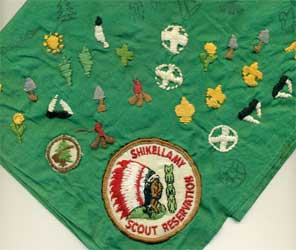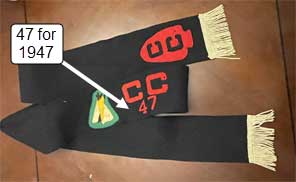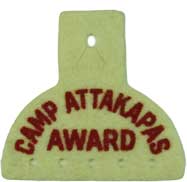|
Camp Achievement Themes and Recognition |
|
|
|
Achievement at camp consisted of meeting requirements to earn recognition.
In the early years Scouts weren’t allowed to work on merit badges until they
were First Class. In the modern era merit badges work at camp is one of the
major themes but that didn’t become widespread until the 1960’s. I have
questioned why merit badge work wasn’t promoted more in the early years but
cannot find a satisfactory reason. The key word in Camp Achievement is
“earned”. Many camps established requirements for themes that would qualify
as “mini” merit badges. Usually themes like Camping, Hiking, Handicraft,
Swimming etc. Scouts earned recognition at camp for mastering these themes. |
|
|
 |
 |
 |
 |
|
Camp Ma Ka Ja Wan-IL. Four different badges for 1932 and there are more. The red
felt behind the 1932 badge means something. The different color threads mean
something. These badges were used at camp after the WWW became the camp honor
group. We need the camp guidebook to understand the program. |
|
|

Stencils on belts or neckerchiefs were a way to recognize achievement. The
stencils on the neckerchief to the right have been embroidered by the owner.
Belt stencils were widely used at camps nationwide. I have a separate section on
belt stencils and neckerchiefs.
 |

Camp achievement and tenure can take on so many forms. This sash is from Memphis
Tennessee’s camp Curry and Camp Kia Kima. Instead of insignia on the Scout
uniform or a neckerchief it was worn on the camp “sash” . CC for Camp Currier
and 47 for 1947. |
|
|
  (Left) Some
camp achievement takes the form of instant recognition. The Cleveland camps used
Racky Racoon as a totem. Bronze gold and silver racoons with multi colored beads
that were awarded usually within the same day the achievement was earned. (Left) Some
camp achievement takes the form of instant recognition. The Cleveland camps used
Racky Racoon as a totem. Bronze gold and silver racoons with multi colored beads
that were awarded usually within the same day the achievement was earned.
(Right) Some camps used a badge that hung from the pocket of the Scout shirt.
Pieces of string, sometimes strips of felt went through holes on the bottom to
indicate achievement. Modern campers sometimes loose sight of the fact that many
camps, particularly in smaller councils, weren’t very sophisticated with their
insignia. Costs were always a concern.
|
|
|
 |
|
|
Paul Myers Goshen,
Indiana
gimogash@comcast.net |
